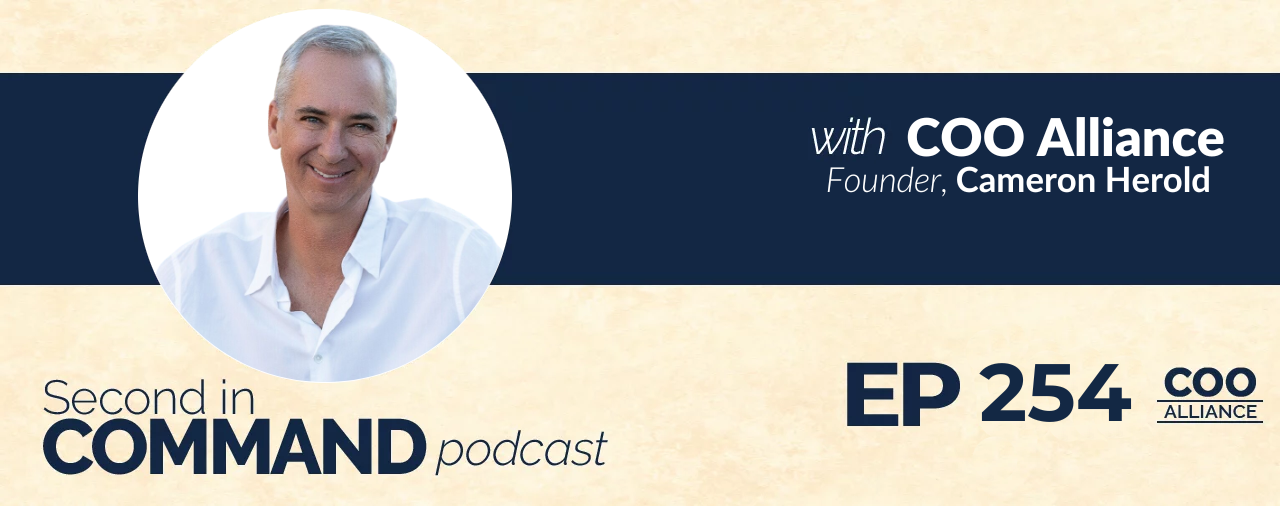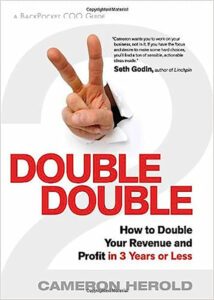Today’s episode features a presentation Cameron gave called Vivid Visions, in which he outlines the reasons why vision statements just don’t work.
In this presentation, Cameron offers evidence of why the standard, single-line vision statement simply doesn’t work. He offers anecdotes about a high-profile sports psychologist who tried to apply the concept of visualization to business, and why that strategy didn’t work. He uses the example of a contractor who is given detailed blueprints of the dream home you want built to illustrate the way a business needs to approach the idea of a vivid vision. Your team needs to understand the details of where you want the business to go in order for them to make that happen. He also uses the example of a client, who he has coached for four years, from 50 employees up to 700 employees, and who has just raised $255 million from Warburg Pincus, one of the top-tier investment banks. They bought into the company at about a $2 billion valuation, all because of the dream of the vivid vision.
In This Conversation We Discuss:
- Why the concept of visualization, used primarily in the sports world, doesn’t work that well for business.
- How to build a vivid vision document – what your business will look and feel like in the next three years.
- Why the CEO’s only job is to communicate the vision, and why a one-sentence statement doesn’t have the traction needed.
- How to articulate the vivid vision, and then grow leaders so they can put the plans into action.
Resources:
Connect with Cameron: Website | LinkedIn
Get Cameron’s latest book “Second in Command: Unleash the Power of your COO”
Subscribe to our YouTube channel – Second in Command Podcast on YouTube
Get Cameron’s online course – Invest In Your Leaders
—
Let me ask you a question. Do you have a vision statement for your business? In a few months, almost every CEO will be looking at a yearend statement to see if theirs needs updating. According to Cameron Herold, it doesn’t need updating. It needs to be flushed down the toilet. Vision statements don’t work. Cameron Herold is known around the world as The CEO Whisperer. Some people start out young and burn out quickly, but not Cameron. At 21, he employed fourteen people. At 35, he built his first of two $100 million companies. By 42, Cameron engineered 1-800-GOT-JUNK?, the world’s largest residential junk removal company with spectacular growth from $2 million to $106 million in revenue and 3,100 employees, and he did it in six years.
What he did was so impressive that it became a case study at Harvard Business School. He’s now a coach to a monarchy and a Big Four wireless carrier as well as dozens of CEOs and COOs. His successes and the occasional failures have given him insight into the tried and true systems that work. Cameron’s title is Vivid Vision. Please welcome Cameron Herold.
Thank you very much. Who has a vision statement or a mission statement, that one-sentence statement? The reason is I want to tell you to throw it out. The concept of the Vivid Vision I originally rolled out in my first book, which is called Double Double, ended up on Richard Branson’s Necker Island, but when the island got destroyed by the hurricane back in September, my book ended up somewhere out in the Atlantic.
I had to write the book Vivid Vision to document it a little bit more thoroughly for you. Most of us had a blank whiteboard in our offices. We took a bunch of the words, threw them up on the whiteboard, and eliminated words. We ended up with our little mission statement. The reason that it doesn’t work and has never worked is it’s never given our employees enough of a full picture of what we’re thinking about,
Many years ago, I was invited to a luncheon with 120 entrepreneurs in Vancouver, Canada. We were told to look into a crystal ball. We thought that was a flaky idea looking into the crystal ball. We didn’t know how to apply it to the business world, but it was a high-performance sports psychologist talking to us about visualization. He was talking about how athletes will visualize themselves performing at the event and how athletes will roll themselves through the event.
They’ll close their eyes and picture themselves going over and over through the event. That process of visualization helps them compete completely on instinct. We didn’t know how to take that analogy into the business world so we looked for another analogy. He told us about Brooke Shields. He said, “When Brooke was getting married to Andre Agassi, she didn’t like her legs, so she put a picture of what she wanted her legs to look like up on the refrigerator.” We know that the marriage between Andre Agassi and Brooke Shields didn’t work out. He ended up getting married to Steffi Graf. The crazy thing was those were Steffi Graf’s legs on the refrigerator. The process of visualization did work. Unfortunately, it worked for Andre.
The number one thing you’re learning now is to go home and take down all the photos off your refrigerator. That still didn’t help us. We didn’t know how to take the concept of visualization and bring it into the business world, but we found out that home builders use visualization every day. If any of you have built a house or done a renovation, think back to that process.
That time when you were first meeting with the contractor, you were the CEO of the Home Building Project. You were the one who had the vision of the home. You didn’t give the contractor a one-sentence statement to say, “Build me my dream home. Here’s $2 million,” and leave. That’s a vision statement. That one sentence, “Build me my dream home and I’ll go away for a year,” they’re going to screw it up because they can’t read your mind. You gave them sketches, drawings, and pictures.
You talked about how your family entertained, how you use the home, how many kids would you have, and where your friends would be. You told them more so they could take your vision and go away and create blueprints. You then come back with the blueprints, hand the blueprints to your employees, and the employees can recreate your dream. That’s where the analogy of the Vivid Vision started to come from.
The Vivid Vision becomes a 4 or 5-page written document describing your company three years and only three years from now in the future. You roll your camera ahead on December 31st three years from now, and I want you to think about what your business looks, acts, and feels like. I’ve given you two sample copies of Vivid Visions for two of my businesses. When you read through those, I want you to ask yourself if you understand my business better than your employees understand yours.
Who’s seen the movie The Sound of Music? Who’s never seen the movie The Sound of Music? Who has no idea what the movie The Sound of Music is about? There’s a famous scene in the movie where they’re having a picnic. I want you to recreate the picnic scene for me perfectly like in the movie The Sound of Music. Should it be in a park, in the mountains, or at a lake? Where do we get the food? Should we get it at a grocery store, at a hut in the park, or should we bring it in a basket? Let’s bring a basket.
Let’s bring the kids to the picnic as well. Should the kids be dancing, playing baseball, or playing croquet? I said, “I need it to be like The Sound of Music,” but because you’ve never seen the movie, you can’t recreate it. It’s in the hills in the Alps, not in a park, and they’re dancing. There was a theme, the sound of music. It wasn’t the sound of croquet, but most of us in our businesses give a one-sentence statement to people and expect them to read our minds. We then get frustrated because we’re intuitive and they’re not. The reason they’re not intuitive is they can’t see what we can see. Your only real job as the CEO is to communicate the vision. It’s to communicate the picture of what your business looks and feels like, and the one-sentence vision statement isn’t enough.
Even in Traction, when they give you the Vision/Traction Organizer which is a list of a bunch of bullet points, it doesn’t explain the full picture of what your company can look like. Imagine doing a jigsaw puzzle without knowing what the picture would be like. You could do it, but it would take a lot longer. If you’re writing a Vivid Vision, you’ve got to get out of the box. You can’t sit in your office and write this. You have to go somewhere where you’re inspired, somewhere around nature. Go to a park, go to the mountains, go sit up at the top of Camelback.
Go sit somewhere where you’re not in your business. There is no laptop, no iPad, and no technology. Take a notepad and I want you to pretend like you’re traveling in the future. You’re hopping into a time machine and you’re going three years out into the future to 2020. I want you to start doing a mind map describing your entire company. Describe operations, three bullet points about operations, marketing, IT, engineering, and sales.
I want you to write down 3 or 4 bullet points about what your customers are saying about you, what the media is writing about you, or what your employees are saying. I want you to talk about your supplier relationships. I want you to talk about the buzz that you feel when you walk in. I want you to talk about the culture, your meeting rhythms, and your dashboards but don’t worry about how it comes true.
Remember, the homeowner’s job is to describe what the home looks like. The contractor’s job is to figure out the plans and the employee’s job is to execute the plans. Your leadership team is the group that figures out the plans to make your vision come true. You articulate the vivid vision and then you grow leaders so they can put the plans in place and then you can coach them and they can coach the team to execute. You get all the bullet points written down from a mind map and you organize them into rough notes. You pull a bunch of the rough notes together and then you can create your first draft of your Vivid Vision.
Jennifer Hudye is not here, but she has written dozens and dozens of the final drafts of Vivid Vision for CEOs all over the world. I get requests all the time from all of my books about Vivid Vision. They all get directed to Jennifer’s team and she helps polish them off the page because you give it to a professional writer and they can pop it. They can take your rough work and make it pop.
You then add some graphic design elements to it. This is a client who I’ve coached for years from 50 employees up to 700 employees. They raised $255 million from Warburg Pincus, one of the top tier investment banks which bought into the company at about $2 billion valuation because of the dream of the Vivid Vision. When you can raise $255 million and you’re only doing $200 million in revenue, they’re buying into something, and it’s not your business plan. They’re buying into the dream.
Your Vivid Vision, when you write it, has to be like a magnet. It has to completely compel people and pull them towards you. If it’s like a magnet, what else does a magnet do? It attracts. What else does it do? It repels. It has to be able to push some people away as well. This is not a Kumbaya group hug. Your job as the CEO is to articulate what you see and what you can feel, and then attract the potential employees, the customers, and the suppliers towards you because they vibrate with you.

Vivid Vision: When you write your vivid vision, it has to be like a magnet. It has to completely compel people and pull them towards you.
I ran this session years ago. I went to a conference, and the CEO brought me in to speak to all of his employees. We ran a big session around it and then he read his Vivid Vision to all of his employees. He said, “About 15% of you hate what you just heard.” He said, “That’s okay. It’s the right time for you to quit, but the 85% of you that love what you just heard, tomorrow, go to this office address because when we’ve been offsite as a company, a moving company came and packed up our entire company and moved all 70 of us to this new location.”
If you’re excited by that idea, it was like, “Let’s do this,” but if you weren’t, 15% of his employees did quit, and a year and a half later, he ranked as the number two company in British Columbia to work for. Another client that I coached, Nurse Next Door, ranked as number one. The alignment around the vision is critical. The one-sentence mission statement has never worked, and we know it’s never worked.
It’s because whenever we created it with our teams, we all walked out saying, “They don’t have the same alignment that I want them to have.” It’s your call. We can try to create picnics like The Sound of Music and end up playing croquet, or you can craft your vivid vision and have everybody on the same page. Thank you.
Important Links






